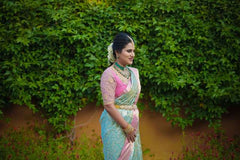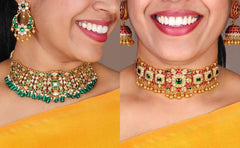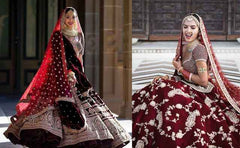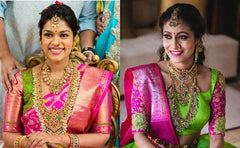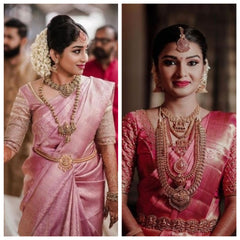
The Magic of the Mangal Sutra
It is the most crucial moment of a marriage. The one that everyone gapes over while flash cameras spark the air. That one that ties it all together, literally! The moment when the groom leans over and ties it around her dainty neck. The Mangal sutra! Mangal meaning auspicious and Sutra meaning thread, it makes up that single gold thread which seems to mean more than anything to a Hindu bride. But there is so much to know about this petite seeming thread of matrimony. Sure we've seen plenty of weddings in our own family to know this much. But do we know enough?  The Mangal Sutra identifies a woman as "married". But do we also know that it has different avatars in different states of India. The Mangal sutra worn by a UP bride looks so different from the
The Mangal Sutra identifies a woman as "married". But do we also know that it has different avatars in different states of India. The Mangal sutra worn by a UP bride looks so different from the
"Thaali" worn by a Tamil bride that we often wonder if they mean the same thing at all! So let's see what is so different about this elusive yellow thread of destiny that seems to hold so much weight.  A traditional, rustic Mangal Sutra is pretty unassuming. A yellow thread with black beads, basted and stained with turmeric paste. It is tied around the brides. Most women continue to wear it, much akin to the women in the West keeping their wedding bands on.
A traditional, rustic Mangal Sutra is pretty unassuming. A yellow thread with black beads, basted and stained with turmeric paste. It is tied around the brides. Most women continue to wear it, much akin to the women in the West keeping their wedding bands on.  The south Indians for the most part call it "Thaali" even though the different Thaalis don't really resemble one another. The Tamil Thaali is heavy crusted called the "Khumba Thaali", while the Malayali version of the same is a tiny little golden leaf. The Kannadigas and Marathis have a similar looking chains distinguished only by the number of black beaded threads or "vatis" as they are known.
The south Indians for the most part call it "Thaali" even though the different Thaalis don't really resemble one another. The Tamil Thaali is heavy crusted called the "Khumba Thaali", while the Malayali version of the same is a tiny little golden leaf. The Kannadigas and Marathis have a similar looking chains distinguished only by the number of black beaded threads or "vatis" as they are known. 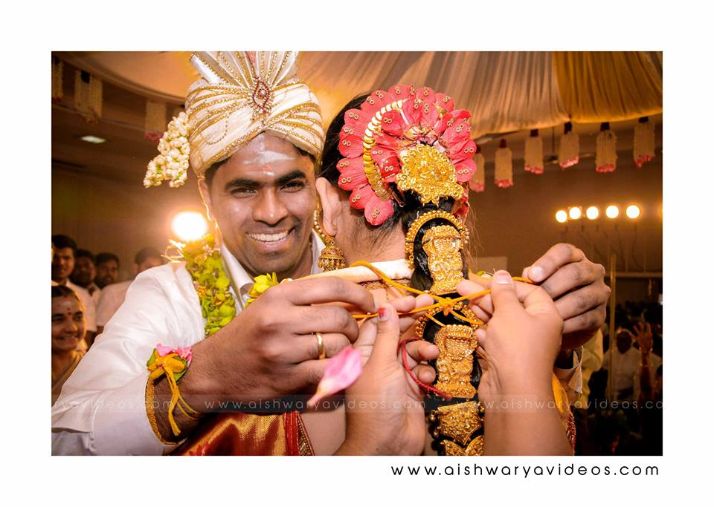 Symbolizing "Mangalya Dharanam" when a groom officially makes his bride his wife, the golden thread is the match-maker that officiates this entire ritual. The "may you live long happily" is not just something we write on gift cards, but also done as a prayer. The Mangal Sutra stands for precisely this. And if movies have taught us anything as children, it is that the Mangal Sutra is tied not once, not twice, but three times! One symbolizes respect to the groom, two symbolizes respect to parents and three symbolizes reverence to god.
Symbolizing "Mangalya Dharanam" when a groom officially makes his bride his wife, the golden thread is the match-maker that officiates this entire ritual. The "may you live long happily" is not just something we write on gift cards, but also done as a prayer. The Mangal Sutra stands for precisely this. And if movies have taught us anything as children, it is that the Mangal Sutra is tied not once, not twice, but three times! One symbolizes respect to the groom, two symbolizes respect to parents and three symbolizes reverence to god.  And though our heavy-powered business suited ladies of the smart-phone decade may not prefer the heavy ornate jewellery, they've found a way to customize. The trend now is to wear it short and sleek in a single string perhaps adorned with a pretty diamond pendant. You can also find it in snazzy colours, minimalist designs, cluster patterns on glitzy rhodium metal and what not! A world of e-shopping sites offer custom designed Mangal Sutra, and your wedding jewellery can now reflect who you are! So, has something so traditional it also become part of someone's style identity? The answer is a big, bold Yes!
And though our heavy-powered business suited ladies of the smart-phone decade may not prefer the heavy ornate jewellery, they've found a way to customize. The trend now is to wear it short and sleek in a single string perhaps adorned with a pretty diamond pendant. You can also find it in snazzy colours, minimalist designs, cluster patterns on glitzy rhodium metal and what not! A world of e-shopping sites offer custom designed Mangal Sutra, and your wedding jewellery can now reflect who you are! So, has something so traditional it also become part of someone's style identity? The answer is a big, bold Yes! 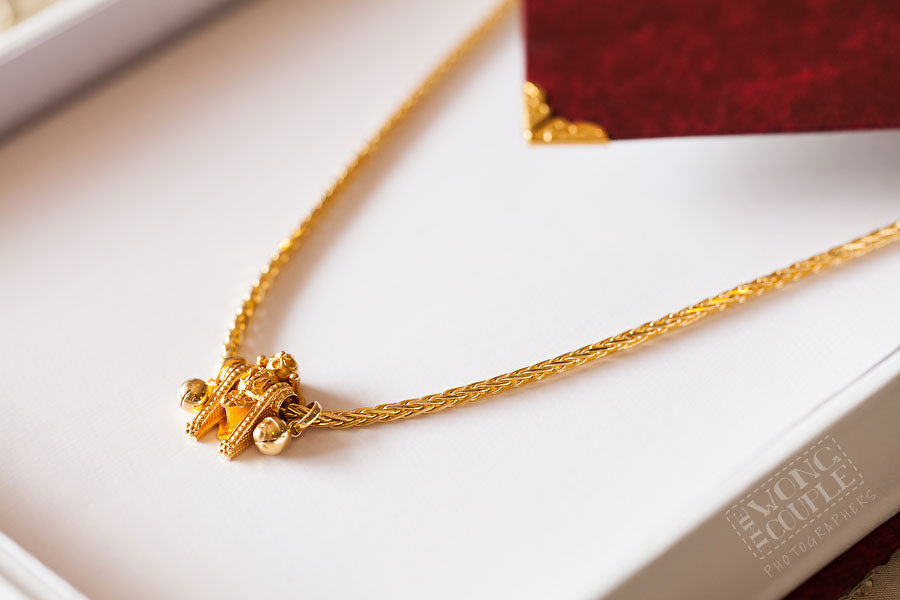 But although the times and trends have given the age old sanctity of Hindu marriage a new perspective, the brides of today still manage to string in those black beads onto their designer "Pestelu" and Mangalsutram, a reminder of what will always be. A beautiful piece in the mosaic of our tradition. Sponsored By: NAC Jewellers, Chennai
But although the times and trends have given the age old sanctity of Hindu marriage a new perspective, the brides of today still manage to string in those black beads onto their designer "Pestelu" and Mangalsutram, a reminder of what will always be. A beautiful piece in the mosaic of our tradition. Sponsored By: NAC Jewellers, Chennai


